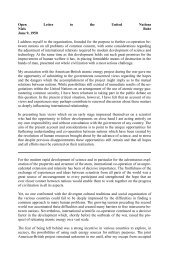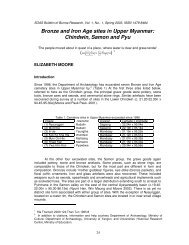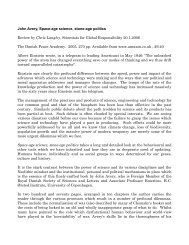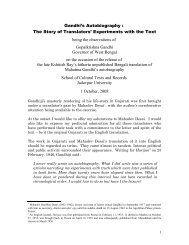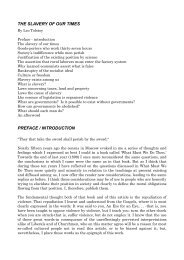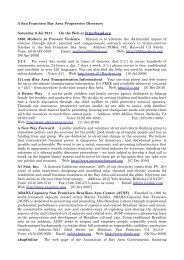History in the new South Africa: an introduction - Det danske ...
History in the new South Africa: an introduction - Det danske ...
History in the new South Africa: an introduction - Det danske ...
Create successful ePaper yourself
Turn your PDF publications into a flip-book with our unique Google optimized e-Paper software.
gold price rose over $800 <strong>in</strong> 1980/1. Fixed <strong>in</strong>vestment dropped from more th<strong>an</strong> 25% of GDP<br />
<strong>in</strong> <strong>the</strong> 1970s to about 18% <strong>in</strong> <strong>the</strong> mid-1980s <strong>an</strong>d productivity growth <strong>in</strong> m<strong>an</strong>ufactur<strong>in</strong>g from<br />
2.3% per <strong>an</strong>num <strong>in</strong> <strong>the</strong> 1960s to 0.5% <strong>in</strong> <strong>the</strong> 1970s <strong>an</strong>d -2.9% dur<strong>in</strong>g <strong>the</strong> first half of <strong>the</strong><br />
1980s. despite slower growth overall, some sectors prospered while o<strong>the</strong>rs decl<strong>in</strong>ed.<br />
Macroeconomic policy favoured m<strong>in</strong><strong>in</strong>g exports, but raised m<strong>an</strong>ufactur<strong>in</strong>g import costs <strong>an</strong>d<br />
lowered profitability. F<strong>in</strong><strong>an</strong>cial <strong>in</strong>stitutions enjoyed a short-term profit boom as mergers <strong>an</strong>d<br />
acquisitions rose <strong>an</strong>d foreign corporations dis<strong>in</strong>vested. Ownership concentration, <strong>an</strong>d <strong>the</strong><br />
economic power of white big bus<strong>in</strong>ess, <strong>in</strong>creased: by 1990, six conglomerates centred on<br />
m<strong>in</strong><strong>in</strong>g <strong>an</strong>d f<strong>in</strong><strong>an</strong>ce controlled comp<strong>an</strong>ies with 80% of <strong>the</strong> market capitalisation on <strong>the</strong><br />
Joh<strong>an</strong>nesburg Stock Exch<strong>an</strong>ge.<br />
An <strong>in</strong>ternational <strong>an</strong>ti-apar<strong>the</strong>id campaign call<strong>in</strong>g for trade s<strong>an</strong>ctions <strong>an</strong>d dis<strong>in</strong>vestment ga<strong>in</strong>ed<br />
momentum as political upheaval <strong>in</strong>creased dur<strong>in</strong>g <strong>the</strong> early 1980s. In 1985 <strong>in</strong>ternational<br />
creditors recalled <strong>South</strong> <strong>Africa</strong>n public sector debt after <strong>the</strong> government declared a state of<br />
emergency. The capital outflows required for debt repayment fur<strong>the</strong>r tightened <strong>the</strong> bal<strong>an</strong>ce of<br />
payments constra<strong>in</strong>t on growth, s<strong>in</strong>ce <strong>in</strong>vestment depended on imports of capital equipment<br />
<strong>an</strong>d <strong>in</strong>termediate goods. These economic pressures helped to shift <strong>South</strong> <strong>Africa</strong>n bus<strong>in</strong>ess by<br />
1989 to support democratisation, as <strong>the</strong>y realised that higher growth depended on access to<br />
<strong>in</strong>ternational capital flows which <strong>in</strong> turn depended on <strong>an</strong> acceptable political settlement<br />
end<strong>in</strong>g apar<strong>the</strong>id.<br />
The crisis re-shaped <strong>the</strong> black class structure <strong>an</strong>d civil society as well. Extreme <strong>in</strong>equality<br />
between races which was characteristic of <strong>the</strong> ‘gr<strong>an</strong>d apar<strong>the</strong>id’ period from 1948 to <strong>the</strong> end<br />
of <strong>the</strong> 1960s was moderated dur<strong>in</strong>g <strong>the</strong> 1970s, as more blacks with education <strong>an</strong>d skills found<br />
work: employment <strong>in</strong> <strong>the</strong> services sectors grew, <strong>an</strong>d technical <strong>an</strong>d white-collar occupations<br />
<strong>in</strong>creased <strong>the</strong>ir share of <strong>the</strong> labour force <strong>in</strong> all sectors. The number of <strong>Africa</strong>ns <strong>in</strong> ‘middle<br />
class’ occupations grew at more th<strong>an</strong> 6% per <strong>an</strong>num, nearly trebl<strong>in</strong>g between 1970 <strong>an</strong>d 1987<br />
when 19% of employed <strong>Africa</strong>ns were <strong>in</strong> middle class jobs <strong>an</strong>d <strong>Africa</strong>ns comprised nearly<br />
25% of <strong>the</strong> middle class, with Coloureds <strong>an</strong>d Indi<strong>an</strong>s <strong>an</strong>o<strong>the</strong>r 18%. But <strong>the</strong>re was <strong>in</strong>creased<br />
class differentiation <strong>an</strong>d <strong>in</strong>equality with<strong>in</strong> race groups after 1975, as layoffs rose <strong>an</strong>d job<br />
creation amongst low-skill blacks was non-existent. <strong>Africa</strong>n unemployment was unofficially<br />
estimated at 11.8% <strong>in</strong> 1970 <strong>an</strong>d 20.8% <strong>in</strong> 1980, with job losses primarily amongst unskilled<br />
<strong>Africa</strong>n workers <strong>in</strong> m<strong>an</strong>ufactur<strong>in</strong>g <strong>an</strong>d construction.<br />
The grow<strong>in</strong>g urb<strong>an</strong> black professional middle class org<strong>an</strong>ised politically <strong>an</strong>d socially through<br />
professional <strong>an</strong>d bus<strong>in</strong>ess bodies, media <strong>an</strong>d cultural associations, while a powerful trade<br />
union movement emerged, org<strong>an</strong>is<strong>in</strong>g semi-skilled <strong>an</strong>d unskilled black workers both <strong>in</strong> <strong>the</strong><br />
workplace <strong>an</strong>d outside it, work<strong>in</strong>g with community org<strong>an</strong>isations <strong>an</strong>d women’s <strong>an</strong>d students’<br />
groups. The exiled nationalist movement, <strong>the</strong> ANC, provided strategic focus to support<br />
<strong>in</strong>ternal political opposition, while also mount<strong>in</strong>g low-key armed struggle <strong>an</strong>d lead<strong>in</strong>g<br />
<strong>in</strong>ternational boycott pressures. As <strong>the</strong> 1980s proceeded, both black org<strong>an</strong>isations <strong>an</strong>d white<br />
power holders outside <strong>the</strong> state came <strong>in</strong>creas<strong>in</strong>gly recognised <strong>the</strong>ir common <strong>in</strong>terest <strong>in</strong><br />
establish<strong>in</strong>g non-racial democracy. In 1989, black trade unions <strong>an</strong>d white big bus<strong>in</strong>ess<br />
campaigned toge<strong>the</strong>r for <strong>the</strong> first time aga<strong>in</strong>st state repression <strong>in</strong> <strong>in</strong>dustrial relations, which<br />
was a major step not only towards non-racial democracy but also a tr<strong>an</strong>sition via negotiations,<br />
<strong>in</strong>stead of <strong>the</strong> h<strong>an</strong>dover of power by a defeated apar<strong>the</strong>id state.<br />
The form of <strong>the</strong> tr<strong>an</strong>sition reflected <strong>the</strong> prevail<strong>in</strong>g bal<strong>an</strong>ce of class power at <strong>the</strong> time <strong>an</strong>d<br />
def<strong>in</strong>ed <strong>the</strong> possibilities <strong>an</strong>d limits of <strong>the</strong> negotiated outcome. The start of formal political<br />
negotiations gave impetus to <strong>an</strong> already-lively debate about post-apar<strong>the</strong>id economic policy,<br />
16





